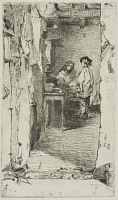Etchings Institutions search term: grolier club
Rag Pickers, Quartier Mouffetard, Paris | ||
| Number: | 29 | |
| Date: | 1858 | |
| Medium: | etching and drypoint | |
| Size: | 152 x 90 mm | |
| Signed: | 'Whistler' at lower right | |
| Inscribed: | '1858' at lower right (5) | |
| Set/Publication: | no | |
| No. of States: | 5 | |
| Known impressions: | 80 | |
| Catalogues: | K.23; M.23; T.31; W.17 | |
| Impressions taken from this plate (80) | ||
KEYWORD
TITLE
'Quartier Moufetard' [sic] (1870s, Whistler). 3
'Interieur de Chiffonier' (1874, Flemish Gallery). 4
'The Rag Shop' (1874, Ralph Thomas, Jr (1840-1876)). 5
'Quartier Moufetard' [sic] (1881, Union League Club). 6
"The Rag-Gatherers'" (1886, Frederick Wedmore (1844-1921)). 7
'Rag Pickers - Paris' (1887/1888, Whistler). 8
'Les Chiffoniers' (Rag Gatherers)' (1905, Paris). 9
'Quartier Mouffetard' (1909, Howard Mansfield (1849-1938)). 10
'The Rag-Gatherers' (1910, Edward Guthrie Kennedy (1849-1932)). 11
The etching looked quite different in early and late states- in early states it was indeed 'Interieur de Chiffonier', the interior of a rag-pickers' shop, with no figures included. This makes sense of Wedmore's title, which suggests premises belonging to rag-pickers.
It is simply not possible to reconcile all these variations, although a composite title - Rag Pickers, Quartier Mouffetard, Paris - covers most of the possibilities.
4: London Pall Mall 1874 (cat. no. 46).
5: Thomas 1874 (cat. no. 31).
6: New York 1881 (cat. no. 12).
7: Wedmore 1886 A (cat. no. 17); note the possessive ' is printed in the catalogue.
8: [August 1887/1888], GUW #13233.
9: Paris Mem. 1905 (cat. no. 298)
10: Mansfield 1909 (cat. no. 23).
11: Kennedy 1910 (cat. no. 23).
DESCRIPTION
SITE
 ). The quartier Mouffetard is in the fifth arrondissement (the Latin quarter), and is one of the oldest Paris village neighbourhoods, with a popular market. It escaped the modernisation of the city by Baron Hausmann from 1860 on, and was a squalid area, dark, damp and dirty, prone to disease and disorder. A possible derivation for the name of the area is the appropriate word 'moufettes' (skunk), from the appalling smells connected with animal and leather processing, sewage and poor drainage. Nevertheless it was cheap and appealed both to the poorest workers, carters, beggars, hucksters, rag and bone men, seamstresses, and to poverty stricken artists and writers. It was also considered picturesque, and tourists looked upon it as a completely foreign world and a glimpse of another age. 12
). The quartier Mouffetard is in the fifth arrondissement (the Latin quarter), and is one of the oldest Paris village neighbourhoods, with a popular market. It escaped the modernisation of the city by Baron Hausmann from 1860 on, and was a squalid area, dark, damp and dirty, prone to disease and disorder. A possible derivation for the name of the area is the appropriate word 'moufettes' (skunk), from the appalling smells connected with animal and leather processing, sewage and poor drainage. Nevertheless it was cheap and appealed both to the poorest workers, carters, beggars, hucksters, rag and bone men, seamstresses, and to poverty stricken artists and writers. It was also considered picturesque, and tourists looked upon it as a completely foreign world and a glimpse of another age. 12
12: See Anon., 'Le Quarter Mouffetard', Journal Amusant, 1874, Achenbach Foundation for Graphic Arts 1963.30.18896, Fine Arts Museums of San Francisco.
DISCUSSION
13: Wedmore 1886 A (cat. no. 17).
14: Delteil & Wright 27 III, Schneiderman 38 III, British Museum, 1862.1011.692; see http://www.britishmuseum.org.
En ce gite si sombre?
Qui donc lá se cachait,
Dans la nuit et dans l'ombre?'
15: Lochnan 1984 , pp. 28, 50, 52, 127.

